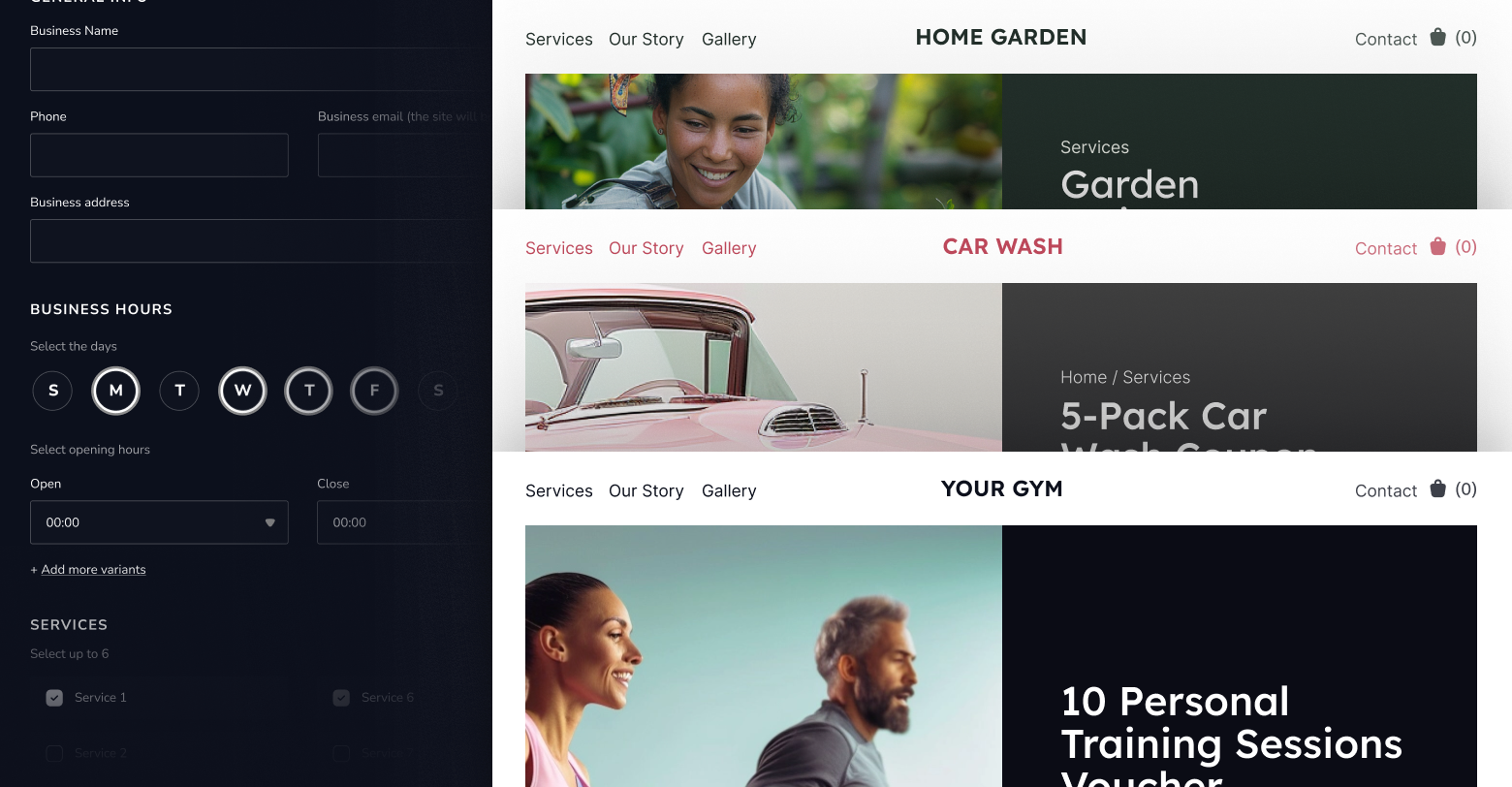Understanding the different website types you can offer your clients with the Duda platform is essential.
I know it sounds obvious, but trust me, it’s not.
Sure, you’ve got your typical types of websites available on many platforms, such as business websites, eCommerce websites, portfolio websites, and so on. Not really groundbreaking information, especially for digital agencies that have been around the website design block and are acquainted with all the different types of websites.
But there are hidden gems in the Duda platform I wish to discuss today.
These are less conventional types of websites that your clients may not be familiar with.
This blog post aims to expose you and your clients to three types of websites you can create with Duda and will present you with unique opportunities to create the precise digital presence you've been looking for.
Transactional sites - eCommerce for non-retail clients
As more and more people shift to transact online in the post-COVID reality, eComm capabilities are becoming a MUST for SMB sites, something their customers are now expecting. In fact, eCommerce sales worldwide are set to increase by almost 50% in the next few years, according to
Statista.
However, most digital marketing agencies want nothing to do with eCommerce.
Can you blame them?
For years, the eCommerce space has been dominated by complex or expensive solutions that are quite the ‘overkill’ for small businesses' relatively simple needs. The fear of investing, constantly maintaining, and training teams on a handful of new technologies (eComm platform, payment gateways, analytics tools, product catalogs, tax and shipping solutions) created inherent resistance by agencies, who actively chose to sit out on a true business opportunity.
In addition, most clients usually consist of plumbers, constructors, veterinarians, beauty salons, real estate agents, etc. - service-based businesses for which the term “eCommerce” is fairly foreign. This doesn’t come as a surprise since the way eComm platforms were historically built and marketed, was to cater to retail-based businesses selling physical products. This has resulted in the (mis)conception that generating revenue online is for product-based businesses only. In other words, it’s long been understood that eCommerce = retail.
Not anymore.
Duda’s transactional sites allow agencies to
turn brochure-style client sites into 24/7 money-makers in minutes, catering to a broad range of transactions beyond traditional retail. From selling services to event tickets, gift vouchers, digital files, and collecting donations - no client is left out of the game.
Examples include beauty therapists selling products, lawyers offering consultation bookings, fitness instructors providing online class registrations, and event organizers selling tickets. Even non-profits can benefit by creating dedicated donation pages to streamline contributions.
What’s in it for agencies?
Agencies can benefit immensely from developing transactional websites. For starters, these sites offer a higher client lifetime value (LTV) by embedding the agency's services directly into the client's revenue stream. This integration fosters client loyalty and positions the agency as a long-term partner, essential for retaining clients and securing a steady monthly income. Transactional websites also present opportunities for upselling additional services such as content creation, social media management, and pay-per-click (PPC) advertising, all of which can drive revenue-based conversions.
The flexibility of transactional websites allows agencies to offer clients a tailored approach to eCommerce without the extensive upkeep associated with traditional online stores. Pricing for services often remains stable, reducing the need for frequent updates. By eliminating the complexities of inventory management and product catalogs, agencies can focus on optimizing the site for transactions and conversions.
What’s in it for clients?
For clients, the advantages of transactional websites are equally compelling. These sites save time by automating the sales process and providing a clear return on investment. Clients can wake up to new orders without having to engage in active selling, allowing them to see their website as a valuable asset rather than a cost. Additionally, transactional sites facilitate customer retention by enabling businesses to collect customer information for promotional purposes, fostering ongoing engagement through targeted email campaigns.
Related:
Why transactional client sites are a golden ticket for growth
8 digital products your clients can start selling today
Membership websites - Redefining exclusive access
Duda's membership websites are designed to offer exclusive content and features to registered members of a site. These websites include gated sections that are only accessible to users who sign up for membership, which can be either free or paid. The membership functionality enables businesses to create a range of specialized areas, such as online communities, educational hubs, professional services portals, and internal dashboards for employees or partners.
What’s in it for agencies?
For agencies, the ability to design and implement membership sites represents a significant opportunity to deliver additional value to clients, enhancing their digital presence while potentially generating new revenue streams. Agencies can create custom membership plans that fit their clients' specific needs, including setting up different tiers of access and managing user permissions.
What’s in it for clients?
For clients, the introduction of a membership site can lead to increased revenue and customer loyalty. Subscription-based models allow businesses to offer exclusive content or services, which is especially valuable in today’s subscription economy, where consumers are accustomed to paying for access to high-quality content. Additionally, by offering tiered membership levels, clients can cater to different segments of their audience, providing basic access for casual users and premium access for more dedicated customers. This approach not only maximizes revenue but also enhances customer satisfaction and retention.
Moreover, by tracking member activities and preferences, businesses can gain a deeper understanding of their audience. This information is crucial for making informed decisions and improving the overall user experience. Agencies can leverage this data to refine their clients’ digital strategies, ensuring that content and services are aligned with what users find most valuable.
Related:
Membership websites: Why you should consider them for your clients
Instant Sites - Good things come to those who DON’T wait
In the world of website creation, timing is everything.
That’s why Duda’s Instant Sites are just the right thing for agencies and clients who don’t want to wait.
Here, it’s not so much the “what” as it is the “how”.
Duda’s Instant Sites allow agencies and their clients to create entire websites instantly, hence the name, offering unparalleled speed, efficiency, and convenience.
By piping business data and content into the platform via the API and selecting a template, a fully functional site is created effortlessly.
As an agency, you can utilize virtually any third-party dataset to generate Instant Sites. Whether it's customer data from past services or lead generation forms, you can spin up a website in no time using just this data.
What’s in it for agencies?
Agencies can use Duda’s Instant sites for many purposes, from using them as a lead generation and sales tool (offering prospects free instant sites via PPC campaigns or during a demo) to leveraging them as a low-entry offering that is meant to upsell clients to higher-ticket products and services.
What’s in it for clients?
For clients, Duda’s Instant Sites offer an immediate solution to establishing their online presence with minimal time and financial investment. These sites provide a cost-effective entry point into professional website development, allowing clients to quickly launch their websites and start attracting customers. Additionally, Instant Sites offer flexibility and scalability, enabling clients to upgrade and expand their websites as their business grows. This means that clients can get a high-quality website up and running in no time, setting the foundation for their online success without breaking the bank.
Final note
Duda offers a diverse range of website types that go beyond the traditional models, providing unique opportunities for agencies and clients alike. Whether it's transactional sites for non-retail clients, membership sites offering exclusive content, or the innovative Instant Sites for rapid deployment, Duda equips you with the tools to create impactful digital presences that drive results.
Want a taste of Duda?
Start a free trial







